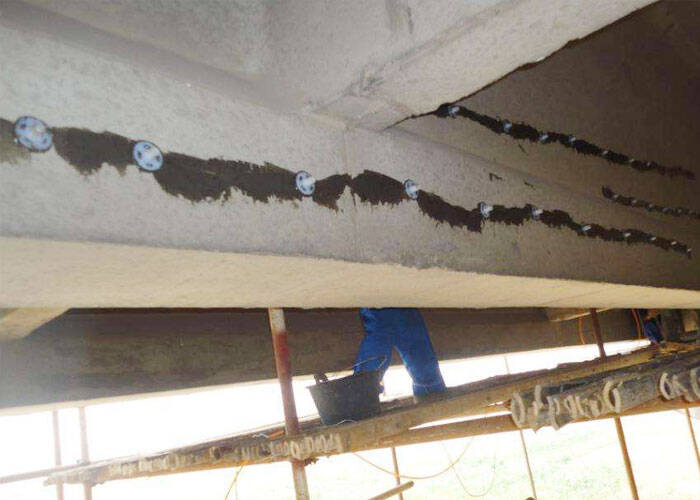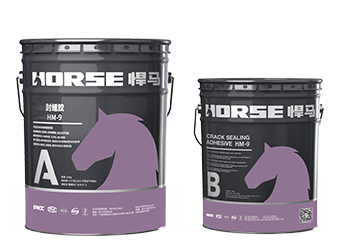Solutions
Horse Construction offers full range of structural strengthening materials with technical supports, documentation supports, products supports, project supports.
Analysis, Judgment, And Treatment Of Structural Cracks In Concrete Beams
The previous article mentioned the analysis, judgment, and treatment of cracks in concrete structures - column section, which is very popular. Today, we will continue to bring you an article on the analysis and treatment of structural cracks in concrete beams.

The different stress conditions of the beam can cause different forms of cracks. From the perspective of beam force, horizontal beams mainly bear the load of plates, and sometimes they may also be subjected to concentrated loads. The main effect of beam bearing capacity is bending moment, with more positive bending moments at the mid span of the beam; There are more negative bending moments on the edge of the support, and in some cases, there are also significant shear forces.
Locally concentrated suspended loads may cause tensile cracks. Such cracks are prone to structural damage and should be reinforced promptly.
Due to different load-bearing and constraint conditions, there are two types of vertical cracks generated by beam bending: negative moment cracks at the top of the beam at both ends and positive moment cracks at the bottom of the mid span beam. Occasionally, bending and compression cracks may occur due to concrete fragmentation in the compression zone.
Under conditions such as edge beams and asymmetric loads, they may also be subjected to torsional forces, resulting in various cracks that intersect diagonally with the beam axis.
Concrete components may accumulate restrained tensile stress due to temperature, shrinkage, and other factors, leading to indirect cracks in the middle of the beam. These types of cracks will be perpendicular to the beam axis and sometimes constrained by reinforcement, resulting in jujube shaped cracks at the waist of the beam.
This article takes the location and morphology of cracks in concrete structures as clues, lists the causes, properties, and impact on structures of 14 common cracks, and provides targeted treatment suggestions.
1.
Cross edge beam waist area
Diagonal crack, wide in the middle and narrow at both ends
Reasons for crack formation?
Insufficient concrete strength
Concentrated load action
Section too small
Local defects
Insufficient reinforcement of hoop reinforcement
Crack?
Stress cracks
Abdominal shear crack
The impact of cracks?
Insufficient shear bearing capacity
Easy to cause brittle failure
Affects durability
Crack treatment?
Cover it up
Reinforcement treatment if necessary
2.
Concentrated load to span edge
Diagonal through, the beam is divided into two halves
Reasons for crack formation?
Insufficient concrete strength
Concentrated load at large shear spans
Section too small
Local defects
Insufficient reinforcement of hoop reinforcement
Crack?
Stress cracks
Diagonal opening crack
The impact of cracks?
Insufficient shear bearing capacity
Causing brittle failure
Affects durability
Insecurity
Crack treatment?
Reinforcement treatment
3.
Concentrated load zone at the edge of the beam
Cross edge diagonal serrated cracks
Reasons for crack formation?
Large concentrated load on the edge
Insufficient alkali strength
Section too small
Local defects
Insufficient horizontal bending reinforcement and punching failure
Crack?
Stress cracks
Punch cut crack
The impact of cracks?
Insufficient shear bearing capacity
Causing brittle failure
Affects durability
Insecurity
Crack treatment?
Reinforcement treatment
4.
A beam with a large span to height ratio in the middle span
Multiple diagonal parallel cracks across the middle span
Reasons for crack formation?
Differential settlement at both ends
Forced displacement causes constrained internal forces
Crack?
Stress cracks
Abdominal shear crack
The impact of cracks?
Insecurity
Affects visibility
Impact on shear bearing capacity
Affects durability
Crack treatment?
Cover it up
Reinforcement if necessary
5.
Across the middle and lower regions
Vertical cracks from bottom to top, not penetrating
Reasons for crack formation?
Positive bending moment under tension
Dismantling the mold too early
Insufficient strength
Insufficient reinforcement
Crack?
Stress cracks
Construction cracks
The impact of cracks?
Insecurity
Affects visibility
Not affecting load-bearing capacity
Affects durability
Crack treatment?
Cover it up
Reinforcement if necessary
6.
Area below the beam edge
Diagonal curved shape, suspended at the upper part of the beam
Reasons for crack formation?
Cross edge concentrated force
Positive bending moment bending force
Crack?
Stress cracks
Bending shear diagonal crack
The impact of cracks?
Cross edge concentrated force
Positive bending moment bending force cracks develop obliquely under shear force
Crack treatment?
Cover up and handle it
Reinforcement if necessary
7.
Area on the upper side of the beam edge
Diagonal curved shape, suspended at the lower part of the beam
Reasons for crack formation?
Cross edge concentrated force
Negative bending moment bending force cracks develop obliquely under shear force
Crack?
Stress cracks
Bending shear diagonal crack
The impact of cracks?
Insecurity
Affects visibility
When the width is large, it affects the bearing capacity
Affects durability
Crack treatment?
Cover up and handle it
Reinforcement if necessary
You can find anything here you are in need of, have a trust trying on these products, you will find the big difference after that.

High strength, unidirectional carbon fiber wrap pre-saturated to form a carbon fiber reinforced polymer (CFRP) wrap used to strengthen structural concrete elements.

High strength carbon fiber reinforced polymer (CFRP) strip / laminate / plate for structural strengthening and concrete repair

High strength crack sealing repairing adhesive for the fracture surface of concrete crack